- Home
- Neal Stephenson
The Rise and Fall of D.O.D.O.: A Novel Page 3
The Rise and Fall of D.O.D.O.: A Novel Read online
Page 3
I pointed at the bedroll. “How long have you—”
“I shower at the gym if that’s your worry.” He pointed to the closer of the two desks, by the door. “This one will be yours.”
“Oh,” I said, not sure what else to say. “Do you have . . . guns in here?”
“Would that be a problem for you?” he inquired, setting the Chinese food on the table in the middle. “If so, I need to know sooner rather than later because—”
“How much firepower were you expecting to need?”
“Oh, you noticed the gun safes?” he asked, tracking my gaze. “No.” he turned to one of them and punched a series of digits onto the keypad on its front. It beeped, and he swung the door open to reveal that it was stuffed from top to bottom with documents. “I keep the most sensitive material in these.”
My gaze had wandered to my desk. I was looking at the flat-panel display, which was showing a few lines of green text on a black background, and a blinking cursor where it was apparently expecting me to type something in. “Where did you get these computers? A garage sale from 1975?”
“They are running a secure operating system you’ve never heard of,” he explained. “It’s called Shiny Hat.”
“Shiny Hat.”
“Yes. The most clinically paranoid operating system in the world. Since you have an overdeveloped sense of irony, Stokes, you might like to know that we acquired it from hackers who were specifically worried about being eavesdropped on by shadowy government entities. Now they work for us.”
“Have they got the memo about the invention of the computer mouse? Because I don’t see one on my desk.”
“Graphical user interfaces introduce security holes that can be exploited by black hat hackers. Shiny Hat is safe against that kind of malware, but the user interface is . . . spartan. I’ll bring you up to speed.”
His desk was crowded with copies of everything I had been translating for him over the past weeks. My notes were marked up with colored-pencil notes of his own. He transferred some of those to the central table while I set up the Chinese food. He read over my day’s work as we ate.
Then we reviewed all the material to date. It took us until sunrise.
In all the documents I’d deciphered, there was almost no useful information to be gleaned regarding the “how” of magic, which is what I assumed Tristan’s bosses had been hoping for. We discovered some examples of magic, in that we learned what was valued by both the witches themselves and those who employed them. Of highest value was what Tristan called psy-ops (psychological operations—mind control, essentially) and shape-shifting (themselves or others). This was considered a weapon of considerable significance, whether it meant turning oneself into a lion or turning an enemy into a lower form of life. In homage to Monty Python, we employed “newt” as shorthand. Of middling value was the transubstantiation of materials and the animating of inanimate objects. Of low value was space/time-shifting, such as teleportation, which was viewed as a laborious leisure-time diversion across all witch populations. Much of what I had associated with “magic” in my bookish youth was disappointingly absent—there were few references to the mastering of natural forces, for instance. And there was absolutely nothing about the mechanics of making any of it happen.
We did, however, glean something significant about magic’s decline, and this is what led to our next stage of inquiry.
Diachronicle
DAYS 57–221 (WINTER, YEAR 0)
In which Tristan determines to fix magic
AT DAWN, TRISTAN DROVE ME home to collect my library, which had been taking up a significant section of my living room since I’d moved out of my faculty office. He plied me with coffee and croissants until I felt able to start a new day without having completed the previous one. Back at the office, he smiled broadly and presented me with the combination to one of the gun safes. It was full of photocopies of manuscripts, documents, and artifacts I had not yet seen. “At the rate you’ve been working, this box will probably take you about a month.”
“I had no idea there was this much still to do,” I said.
He was pulling documents out of the safe, arranging them on the table. “Why would I hire you for a six-month contract if I only had one month’s work for you? There’s a lot more where this came from. But it should be easier now that we’ve sketched out the general picture. You know what you’re looking for now.”
“I still don’t know why I’m looking for it,” I said.
“You know that’s classified,” he said, almost paternal. “Have a seat. Want some more coffee? Working on a shoestring budget here, but I can spring for Dunkin’ Donuts.”
“DODO,” I said. “Department of . . . Donuts?”
“Do you like sprinkles?” he asked.
While he got donuts, I unpacked my dictionaries and lexica and got to work.
IF MY TRANSLATIONS were to be believed, at the start of the Scientific Revolution (Copernicus in the 1540s, etc.), magic was a ubiquitous and powerful force in human affairs, and witches were both revered and feared members of most societies every bit as much as military leaders or priest-mystics (although they were rarely written about, their work being so often the equivalent of “classified”). However, once the Renaissance gave way to the Enlightenment, magic became less omnipresent and less powerful, especially in institutions of learning and government. Judging by the hundreds of references in the texts, it paled increasingly through the Industrial Revolution—remaining most potent in artistic circles and least potent in philosophical ones (these two populations diverging after many generations of entwining), more potent in societies not blessed with booming industrialization, and slightly more potent too in Islamic cultures—and then it vanished altogether in the nineteenth century. The latest text was dated from July 1851. DODO had not been able to find any references to magic after that, except as something that “once was but is no more.”
I translated the box of photocopied documents in less time than Tristan had anticipated, but there was no letup. I began to dream in dead languages as ancient books, scrolls, and tablets kept coming, delivered to the drab office building almost every morning by unidentified couriers in unmarked vehicles. Department of—Dusty Objects? There were plenty of documents in English or modern Western languages—mostly these were transcripts of early anthropologists interviewing the elders of indigenous peoples. I translated the ones that Tristan couldn’t read for himself, and he built a database. Reader, if you don’t know what a database is, rest assured that an explanation of the concept would in no way increase your enjoyment in reading this account. If you do know, you will thank me for sparing you the details. A dreary enough task even with modern user interfaces, it was a mind-numbing death march when implemented on Shiny Hat. Tristan had to write little computer programs to automate some of the data entry tasks.
One of the things we kept track of was the provenance of each document: Had it come from the Library of Congress? Was it simply downloaded from the Internet? Or was it a rare, perhaps unique original? Did it bear any stamps or markings from library collections? In that vein, a disproportionate number had that mysterious stamp on the title page, an image I’d come to know well: the coat of arms of some aristocratic family, with extra bits of decorative gingerbread all around it. Lacking any other information, I just entered this into the database with the code WIMF. Quite a few of the WIMF documents bore older stamps from no less than the Vatican Library, raising the question of whether the WIMF had stolen them? Or borrowed them and never brought them back? Tristan wasn’t talking.
Almost as fast as they could be translated, more books showed up. We would empty out a new crate and then fill it right up again with books that had already been translated, and the bland couriers would haul them away. To where? Many of the boxes were stenciled with a logo I did not recognize at the time, but which I now know to be a modernized, streamlined version of the brand used since time immemorial by the banking family known as the Fuggers.
<
br /> This phase ate up most of my six-month contract, as a fierce New England winter yielded muddily to spring. Other tenants in the building—scruffy start-up companies, mostly—failed or got funded and moved out. Whenever they did, Tristan made a couple of phone calls and ended up with a key to the space they’d just vacated. In this way, DODO’s footprint in the building expanded. We inherited cheap plastic chairs, duffed-up coffeemakers, and crumpled filing cabinets from the former neighbors. Clean-cut technicians showed up in unmarked cars and put card readers on all the doors, expanding and sealing what Tristan called “the perimeter.” The database grew like a dust bunny under the bed. Tristan thought of ways to query it, to search for patterns. We printed things out, stuck them to the walls, tore them down and did it again, stretched colored yarn between pushpins. We went down blind alleys, then backed out of them; we constructed huge Jenga towers of speculation and then, almost gleefully, knocked them over.
But there was never any doubt as to the gist: some manner of cause-and-effect relationship existed between the rise of scientific knowledge and the decline of magic. The two could not comfortably coexist. To the extent that the database could be cajoled into spitting out actual numbers, it was clear that magic had declined gradually but steadily starting in the middle of the 1600s. It was still holding its own in the opening decades of the 1800s, but plunged into a nosedive during the 1830s. From then through the 1840s, magic declined precipitously. As our store of documents—many written by witches themselves—grew to fill a phalanx of used filing cabinets and gun safes that Tristan scored on Craigslist, we were able to track the decline from year to year, and then from month to month. These poor women expressed shock at the dwindling of their powers, in some cases mentioning specific spells that had worked a few weeks ago but no longer had effect.
As it turns out, in 1851—the year in which I find myself as I scribble these words—all of the world’s technologies were brought together for the Great Exhibition at the newly constructed, magnificent Crystal Palace in Hyde Park, London. Tristan’s hypothesis therefore held that this coming together, this conscious concentration of technological advancement all in one point of space-time, had dampened magic to the point where it fizzled out for good. Like a doused fire, it had no power to re-kindle itself once extinguished.
The causal relationship between the two eluded us for a time. I suggested that magic’s flourishing required people to believe in it, but Tristan dismissed this mentality as belonging more to children’s literature than to reality. He was certain there was a mechanical or physical causality, that there was something about the technological worldview, or technology itself, that somehow “jammed the frequencies” magic used. We both began to read whatever we could about the Great Exhibition in the hopes that it might illuminate something.
(You may notice that I was exceeding by far my responsibilities as a translator. Translating, especially of obscure texts written in extinct tongues, often resembles the solving of a riddle. Here was a riddle to put all others to shame! Tristan’s enthusiasm was infectious and I could not divest myself from it. Having no other responsibilities, I became as preoccupied with his project as he was himself.)
Per Tristan’s suggestions, I took out stacks of books from Widener Library (Harvard had not figured out yet that I’d quit—I suppose Blevins wanted to hide the fact lest it reflect poorly on him). These included tomes on everything from heliography to Queen Victoria’s private life to Baruch Spinoza’s sexual proclivities to Frederick Bakewell to the Tempest Prognosticator to Strouhal numbers. I would bring these to Tristan, and we would divide our time between perusing them and Internet searches.
We soon knew more about the Great Exhibition and its thirteen-thousand-odd exhibits than Prince Albert ever did. We knew more about its showcase, the Crystal Palace, than even Joseph Paxton, the gardener who’d designed the fucking blessed thing. We learned little that was helpful. However, one evening in March, as I sat on the consignment-store couch I’d insisted on bringing in to spruce up the place, and Tristan lolled on the rug (provenance ditto) beside a low table with a beer, each of us bleary-eyed from reading, I encountered a passage in an obscure booklet entitled Arresting and Alluring Astronomical Anecdotes, published in 1897. Here I learned that while the Great Exhibition of 1851 was in process (it lasted for several months), an event of relative interest occurred elsewhere in Europe, to be precise, in Königsberg, Prussia: for the first time in history, a solar eclipse was successfully photographed.
I read this statement aloud. It set Tristan on fire with excitement. He had already suspected that photography in particular, of all technological developments, was the likeliest to have somehow impeded magic. Now, somehow, he was certain. It took me a while to calm him down to the point where he could explain himself.
“I’ll be honest with you: as a physicist, I am a hack,” he admitted. “I majored in it, yes, but I was never employed in that capacity. But if you cut me I still bleed physicist blood. I’ll go to my grave believing that, if magic existed, there’s a scientific explanation for it.”
“That sounds like a contradiction to me,” I said, “since our whole working hypothesis is that science broke it somehow.”
He held up a hand. “Work with me here. Have you ever heard of the many-worlds interpretation of quantum mechanics?”
“Only in cocktail party discourse that would make you roll your eyes and heave deep sighs.”
“Well, there are certain experiments where the results only make sense if the system that’s being observed actually exists in more than one state until the moment when the scientist makes the observation.”
“Is this Schrödinger’s cat? Because even I have heard of that.”
“That’s the classic example. It’s just a thought experiment, by the way. No one ever actually did it.”
“That’s good. PETA would be all over them.”
“Do you know what it is?” Without waiting for me to answer, Tristan went on: “You put a cat in a sealed box. There’s a device inside of the box that is capable of killing the cat, by breaking open a vial of poison gas or something. That device is triggered by some random event generator, like a sample of some radioactive material that either decays—producing a bit of radiation—or doesn’t. You close the lid. The cat and the poison gas and the radioactive sample become a sealed system—you cannot predict or know what has happened.”
“You don’t know if the cat is alive or dead,” I said.
“It’s not just that you don’t. You can’t. There is literally no way of knowing,” Tristan said. “Now, in a classical physics way of thinking, it’s either one or the other. The cat is either alive or dead for real. You just don’t happen to know which. But in a quantum physics way of thinking, the cat really is both alive and dead. It exists in two mutually incompatible states at the same time. Not until you open the lid and look inside does the wave function collapse.”
“Whoa, whoa, you had me until the very end!” I protested. “When did we start talking about—what did you call it? A wave function? And how does that—whatever it is—collapse?”
“My bad,” he said. “It’s just physicist lingo for what I was saying. If you were to express the Schrödinger’s cat experiment mathematically, you’d write down an equation that is called a wave function. That function has multiple terms that are superimposed—it’s not just one thing.”
“Multiple terms,” I repeated bleakly.
“Yeah. A term here means a fragment of math—it is to an equation what a phrase is to a sentence.”
“So you’re saying there is one term for ‘cat is alive’ and another for ‘cat is dead’? Is that what you mean in this usage?”
“Yes, O linguist.”
“And when you say they are superimposed—”
“Mathematically it just means that they are sort of added to each other to make a combined picture of the system.”
“Until it ‘collapses’ or whatever.”
He nodded.
“Multiple terms superimposed is a quantum thing. It is the essence of quantum mechanics. But there is this interesting fact, which is that that kind of math only works—it only provides an accurate description of the system—until you open the lid and look inside. At that point, you see a live cat or a dead cat. Period. It has become a classical system.”
“Department of . . . Deadly Observations?” I asked.
He rolled his eyes.
“Anyway, that’s what you mean by the collapse of the wave function.”
“Yes, it’s just physicist-speak for the thing that happens when all of the superimposed terms—the descriptions of different possible realities—resolve into a single, classical outcome that our brains can understand.”
“Our scientific, rational brains, you mean,” I corrected him.
A look of mild satisfaction came onto his face. “Exactly.”
“But now we’ve circled back to my theory!” I complained.
He looked mildly confused. “Which theory is that?”
“The one that belongs more to children’s literature than to reality—remember?”
“Oh, yeah. People have to believe in magic.”
“Yes!”
“That’s not exactly what I’m saying,” he said. “Yes, human consciousness is in the loop. But hear me out. If you buy the many-worlds interpretation of quantum mechanics, it means that all possible outcomes are really happening somewhere.”
“There’s one world with a live cat and another with a dead cat.”
“Exactly. No kidding. Complete, fully independent realities that are the same except that in one of them, the cat’s dead, and in the other, it’s alive. And the quantum superposition? That just means that the scientist standing there with his hand on the lid of the box is at a fork in the road. Both paths—both worlds—are open to him. He could shunt into one, or the other. And when he hauls the lid open, the decision gets made. He is now in one world or the other and there’s no going back.”

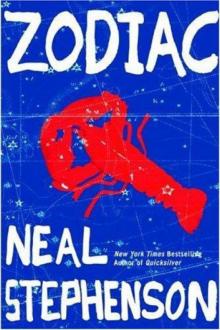 Zodiac: The Eco-Thriller
Zodiac: The Eco-Thriller The Mongoliad: Book One
The Mongoliad: Book One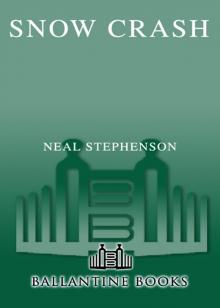 Snow Crash
Snow Crash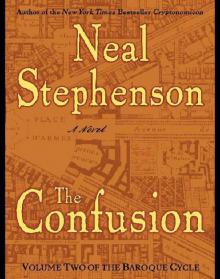 The Confusion: Volume Two of the Baroque Cycle
The Confusion: Volume Two of the Baroque Cycle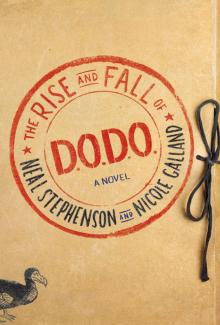 The Rise and Fall of D.O.D.O.
The Rise and Fall of D.O.D.O. The Diamond Age: Or, a Young Lady's Illustrated Primer
The Diamond Age: Or, a Young Lady's Illustrated Primer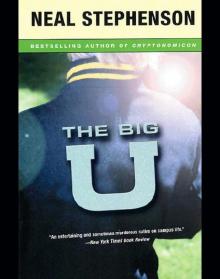 The Big U
The Big U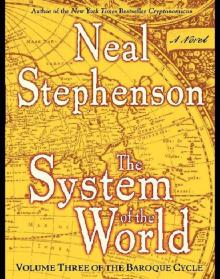 The System of the World: Volume Three of the Baroque Cycle
The System of the World: Volume Three of the Baroque Cycle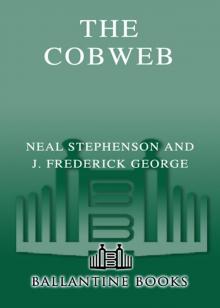 The Cobweb
The Cobweb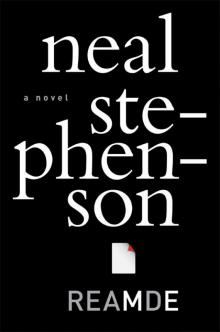 Reamde
Reamde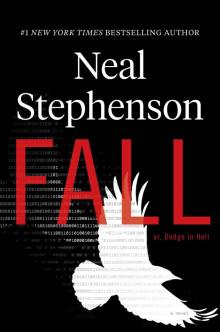 Fall; or, Dodge in Hell
Fall; or, Dodge in Hell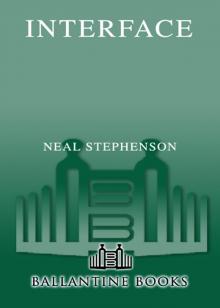 Interface
Interface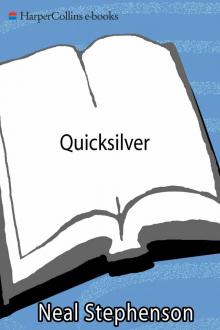 Quicksilver
Quicksilver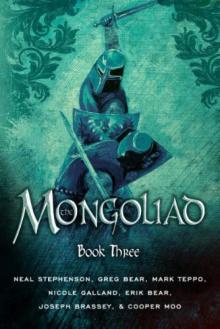 The Mongoliad: Book Three
The Mongoliad: Book Three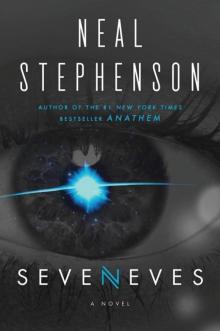 Seveneves
Seveneves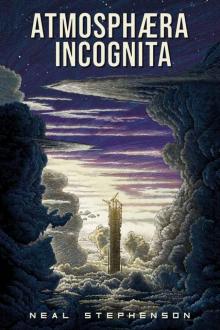 Atmosphæra Incognita
Atmosphæra Incognita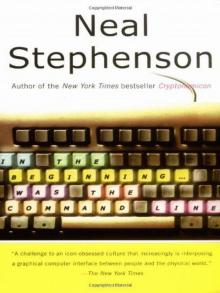 In the Beginning...Was the Command Line
In the Beginning...Was the Command Line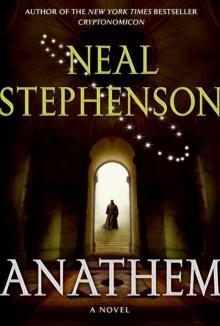 Anathem
Anathem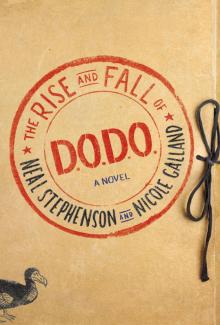 The Rise and Fall of D.O.D.O.: A Novel
The Rise and Fall of D.O.D.O.: A Novel The Mongoliad: Book Two
The Mongoliad: Book Two Diamond Age or a Young Lady's Illustrated Primer
Diamond Age or a Young Lady's Illustrated Primer THE System OF THE WORLD
THE System OF THE WORLD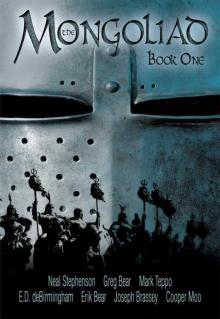 The Mongoliad: Book One tfs-1
The Mongoliad: Book One tfs-1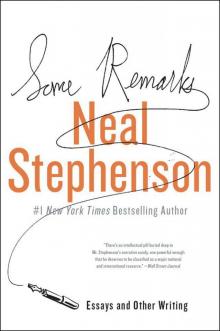 Some Remarks: Essays and Other Writing
Some Remarks: Essays and Other Writing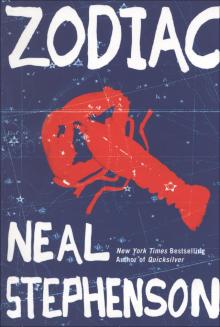 Zodiac
Zodiac Spew
Spew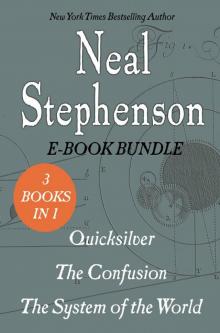 The Baroque Cycle: Quicksilver, the Confusion, and the System of the World
The Baroque Cycle: Quicksilver, the Confusion, and the System of the World The Diamond Age
The Diamond Age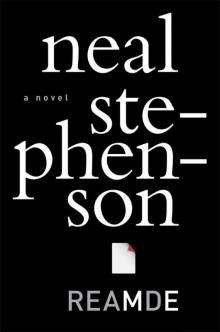 Reamde: A Novel
Reamde: A Novel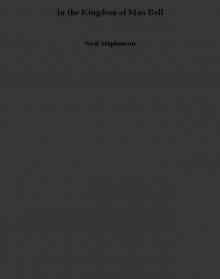 In the Kingdom of Mao Bell
In the Kingdom of Mao Bell Mother Earth Mother Board
Mother Earth Mother Board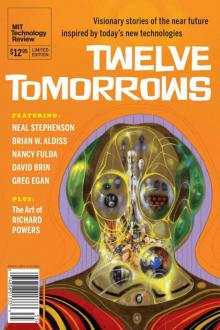 Twelve Tomorrows - Visionary stories of the near future inspired by today's technologies
Twelve Tomorrows - Visionary stories of the near future inspired by today's technologies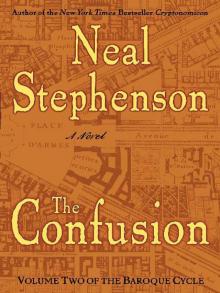 The Confusion
The Confusion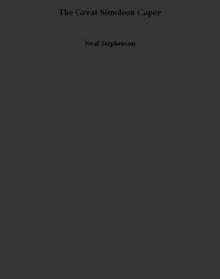 The Great Simoleon Caper
The Great Simoleon Caper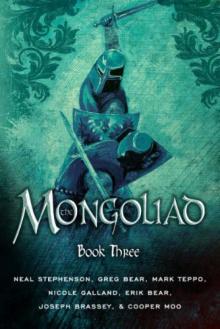 The Mongoliad: Book Three tfs-3
The Mongoliad: Book Three tfs-3